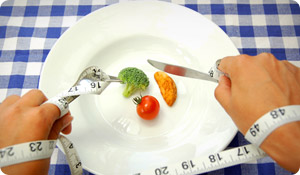
If you're making every effort to slim down, don't assume you have to forego your favorite foods and confine yourself to a diet of raw vegetables. You can eat what you love—just not too much of it.
"Portion control is key to losing and maintaining weight," says Keri Gans, MS, RD, CDN, the author of "The Small Change Diet." "It's not only what you're eating but how much you are eating."
If you want to keep portion sizes realistic, consider these tips from Gans, Alissa Rumsey, RD, of NewYork-Presbyterian Hospital/Weill-Cornell Medical Center in New York City, Suzanne Khanna, program coordinator of the Novo Nordisk Diabetes Center at CentraState Medical Center in Freehold, NJ, and Bonnie J. Brehm, PhD, RD, LD, Professor in the College of Nursing at the University of Cincinnati, in Cincinnati, Ohio.
- Use smaller plates, cups and bowls. "You're less likely to overload if you are using smaller plates," Rumsey says.
- Measure your food with cups and spoons, at least until you get a sense of how large a portion really is. You may be surprised to learn that what you thought was a half-cup serving of mashed potatoes is actually closer to two cups. "If you do this for about a week or two, you will see what a portion size actually is," Khanna says.
- Focus on colorful foods-like fruits and vegetables-and make these the mainstay of your plate.
- Use food labels to identify appropriate serving sizes of packaged foods, Brehm says. You may be surprised that a bottle of juice or a big packaged cookie that you thought was a single serving is actually two to four servings. The calories can add up really quickly, so get savvy about labels.
- Mentally divide your plate into quarters. Fill half with non-starchy vegetables, one quarter with lean protein, and one quarter with a high-fiber complex carbohydrate like brown rice or sweet potatoes.
- Stop serving dinner family-style. Instead, serve the plates in the kitchen and immediately wrap leftovers and put them in the refrigerator. You won't be as tempted to go back for seconds.
- Don't eat while you are watching TV or checking email. Instead, focus on the meal and how much you are enjoying it.
- Never eat out of the bag. Instead, portion out the chips or crackers, and just eat that portion. "It's way too easy to engage in mindless eating when you're eating directly out of the bag," says Rumsey. And, Brehm advises, never ever eat out of large containers such as movie popcorn containers.
- If you dine out, ask your server to put half of your entrée portion right into a bag for you to take home. You won't be tempted to overeat if the food isn't right in front of you. Or share an entrée with a friend. Ask your server to split it in half in the kitchen and bring it to the table on two plates. Another dineout strategy: order an appetizer and a salad instead of an entrée.
- Figure out what your "trigger" foods are and ban them from your house. Replace them with healthy foods, like a big bowl of fruit, and keep these handy. When you're ravenous, you'll be more likely to reach for a piece of cold fruit if it's at eye level in the refrigerator.





